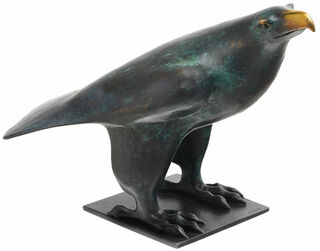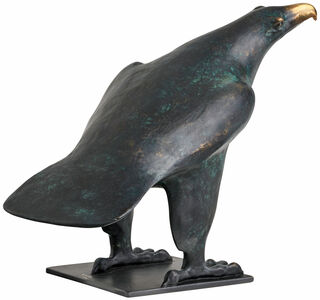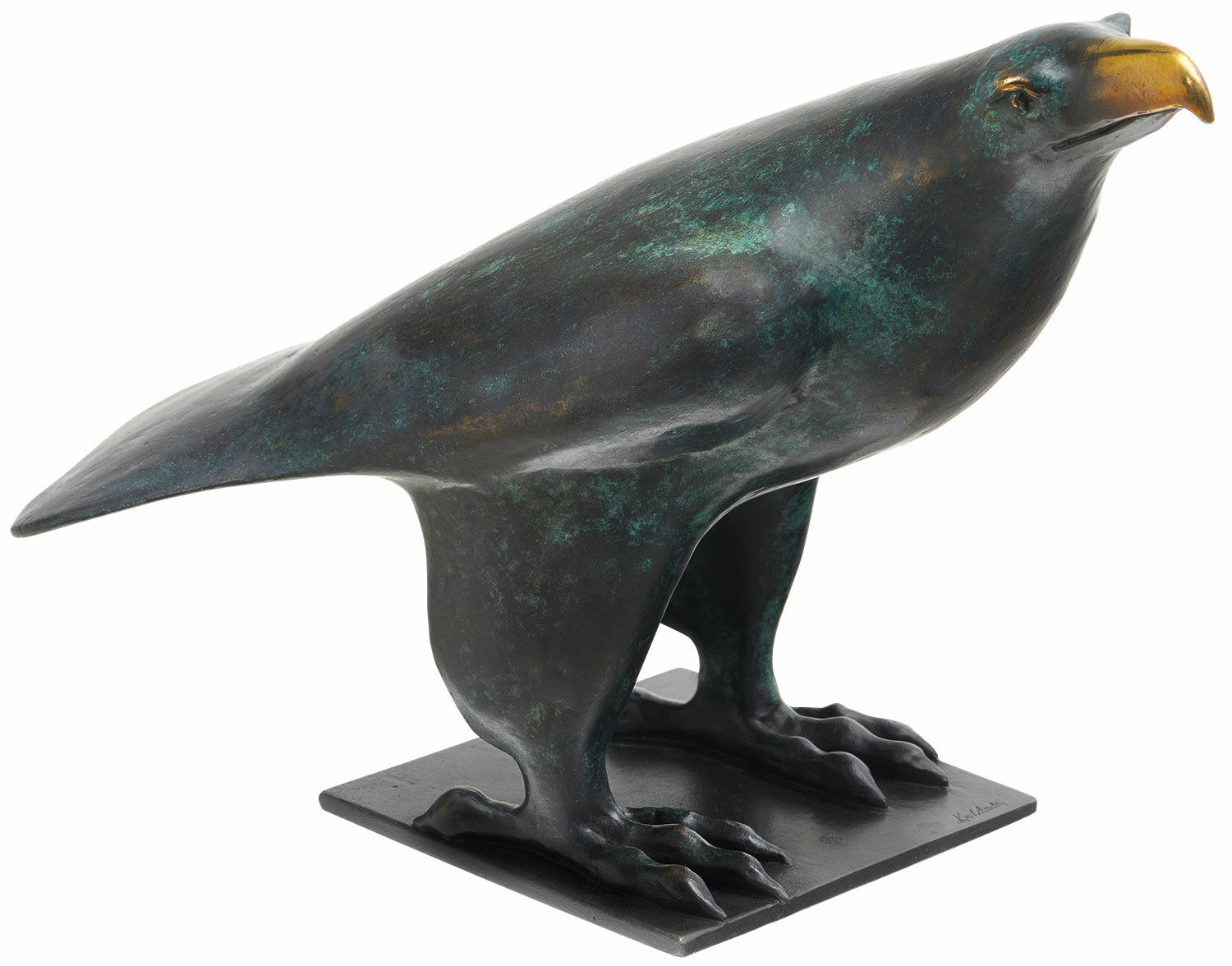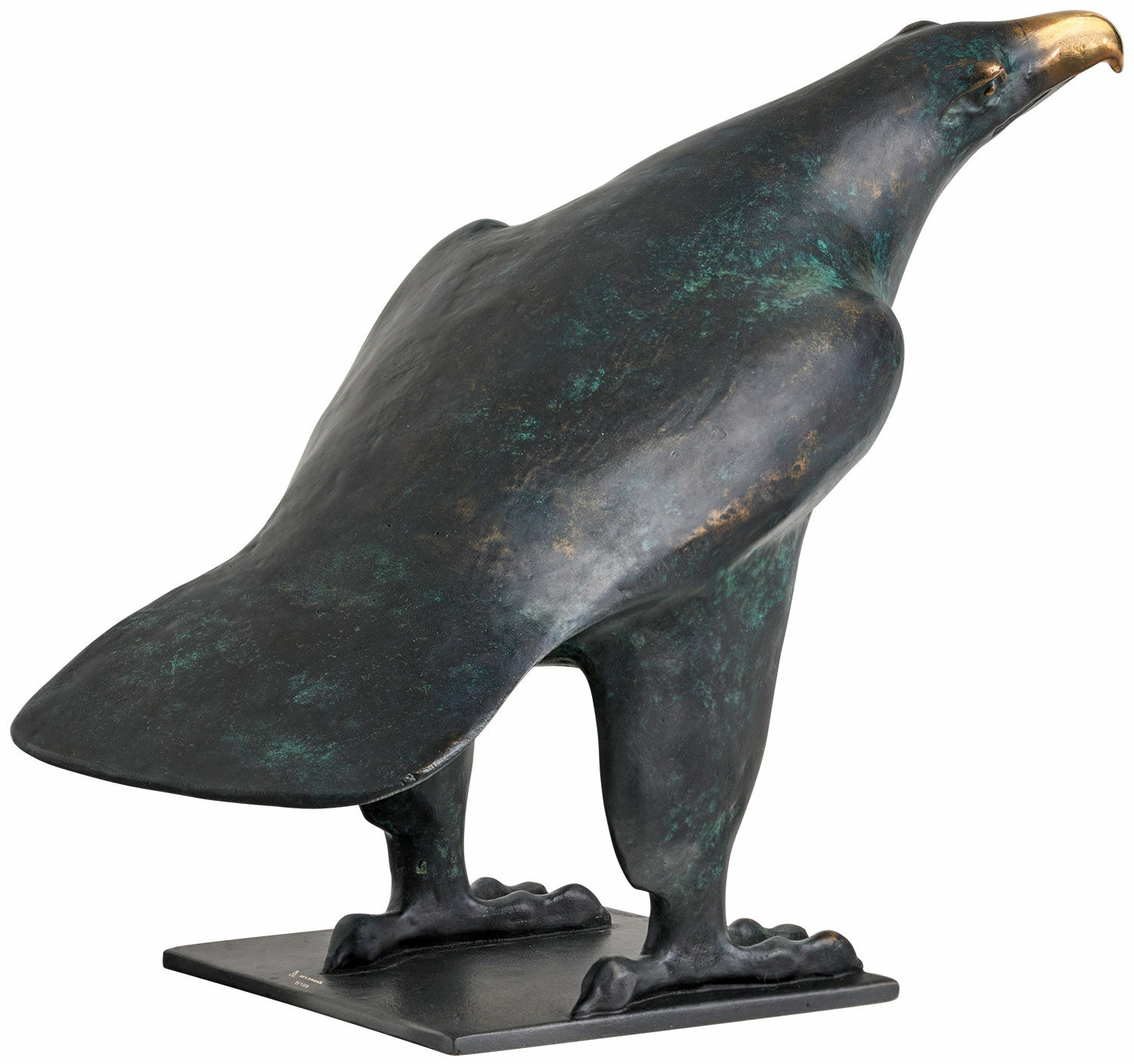Sculpture "Ecological Eagle", bronze reduction
Sculpture "Ecological Eagle", bronze reduction
Quick info
ars mundi Exclusive Edition | limited, 199 copies | numbered | signature | hallmarked | certificate | bronze | chased | polished | patinated | reduction | size 21.5 x 31 x 16 cm (h/w/d) | weight approx. 3.4 kg
Video
Detailed description
Sculpture "Ecological Eagle", bronze reduction
Royal - the "Ecological Eagle" by Kurt Arentz - exclusively at ars mundi.
Kurt Arentz's great interest in ecological issues was closely linked to his fascination with the animal world as a motif in his art. And so Arentz was delighted when his "Ecological Eagle" was selected by the New York committee "Artists for Ecology" as an award for ecologically effective public figures. The choice of the eagle as a motif is a wise one, as it is a proverbial sharp observer of its environment and, at the same time, existentially dependent on it.
The laureate of the award in 1993 was Prince Charles (now Charles III, King of England). When choosing Charles, the committee didn't think of the laureate as the representative of the European royalty but rather the organic farmer and prominent eco-activist, who, as the son of Elizabeth II, already distinguished himself for a long time at that time. In addition to the copy that King Charles received, there is only one other sculpture, which is in the possession of the Arentz family.
Sculpture in fine bronze, cast using the Lost-Wax-Process, chiselled by hand, polished and patinated. Taken directly from the original and reduced in size (reduction). Limited edition of 199 copies, numbered, signed and hallmarked with the foundry and ars mundi stamp. With numbered certificate of authenticity and limitation. Size 21.5 x 31 x 16 cm (h/w/d). Weight approx. 3.4 kg. ars mundi Exclusive Edition.
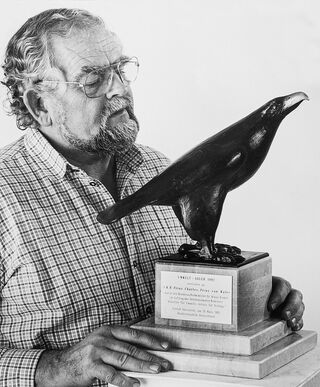
About Kurt Arentz
1934-2014
The German sculptor and painter was born in 1934 in Cologne, as the son of an old-established Bergisch artisan family. He initially learned a trade but then found his own artistic path from 1979 onwards.
At first, he created still lifes in oil and pastel as well as portraits in bronze of celebrities such as Franz Josef Strauß or Herbert von Karajan. Later, he focused mainly on animal motifs emphasising the typical character of each species. As a remarkable self-taught artist, Kurt Arentz found his very own artistic form concept. Beyond academic experiments, but also far from all naturalistic platitudes, he shaped symbols of vital nature with his hands. His ideals of a still-intact world transport us as if into the wilderness. Arentz abstracted the animal as a being in itself. In doing so, he succeeded in placing his works in an era of timeless validity.
For his works, Kurt Arentz used a special silicone rubber process that allowed for the immediate realisation of his ideas. The bronze cast was then signed with the artist's very own signature. In the final work step, the surfaces of the metal were polished, roughened or patinated, thus acquiring their motif-typical characteristics.
The sculptor has already presented his works to a large audience in numerous exhibitions in Germany and France. On his 70th birthday on May 30, 2004, Kurt Arentz was congratulated by former chancellor of Germany Helmut Kohl and former German President Roman Herzog. Arentz was used to receiving frequent acknowledgements and tributes from celebrities: Other fellow statesmen such as Willy Brandt, Ronald Reagan or George Bush Sr., as well as Sir Peter Ustinov and Willy Millowitsch, had their portraits painted by Kurt Arentz.
Nevertheless, Kurt Arentz's great mastery is evident in his animal sculptures. He is considered one of the most significant animal sculptors of the 20th century. In 2001, Arentz was awarded the Order of Merit of the Federal Republic of Germany for his artistic and social commitment. His sculptures are housed in places such as the White House, Washington, and the Museum of European Art in New York.
Like no other, he succeeded in reaching the very essence of the animal and depicting it. The great popularity of these nature studies lies in their strong expressiveness, but also in their carefree cheerfulness: Arentz's creative energy is joy in life.
Kurt Arentz lived and worked in Leverkusen. He passed away in June 2014.
An alloy of copper with other metals (especially with tin) used since ancient times.
When casting bronze, the artist usually applies the lost-wax technique which is dating back more than 5000 years. It's the best, but also the most complex method of producing sculptures.
First, the artist forms a model of his sculpture. It is embedded in a liquid silicone rubber mass. Once the material has solidified, the model is cut out. The liquid wax is poured into the negative mould. After cooling down, the wax cast is removed from the mould, provided with sprues and dipped into ceramic mass. The ceramic mass is hardened in a kiln, whereby the wax flows out (lost mould).
Now we finally have the negative form, into which the 1400° C hot molten bronze is poured. After the bronze had cooled down, the ceramic shell is broken off and the sculpture is revealed.
Now the sprues are removed, the surfaces are polished, patinated and numbered by the artist himself or, to his specifications, by a specialist. Thus, each casting becomes an original work.
For lower-quality bronze castings, the sand casting method is often used which, however, does not achieve the results of a more complex lost-wax technique in terms of surface characteristics and quality.
Graphic or sculpture edition that was initiated by ars mundi and is available only at ars mundi or at distribution partners licensed by ars mundi.
Term for an art object (sculpture, installation), which is produced in multiple copies in a limited and numbered edition according to the artist‘s will.
Artist's multiples have been called the most accessible and affordable art on the market.
A plastic work of sculptural art made of wood, stone, ivory, bronze or other metals.
While sculptures from wood, ivory or stone are made directly from the block of material, in bronze casting a working model is prepared at first. Usually, it is made of clay or other easily mouldable materials.
The prime time of sculpture after the Greek and Roman antiquity was the Renaissance. Impressionism gave a new impulse to the sculptural arts. Contemporary artists such as Jorg Immendorf, Andora, and Markus Lupertz also enriched sculptures with outstanding works.

